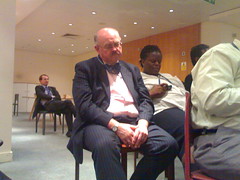 We have all been there. The meeting. A room full of folks listening to a speaker, occasionally taking the baton and sharing some insight, knowledge or point of view — but generally the talk is all one-way.
We have all been there. The meeting. A room full of folks listening to a speaker, occasionally taking the baton and sharing some insight, knowledge or point of view — but generally the talk is all one-way.
Research, however, shows us that it is actually the speakers who benefit from the time that they spend in meetings — retaining 90% of what they share. Events like staff meetings, team get-togethers, lectures and the like continue to be a fact of office life because they benefit the talker who dominates them — the speaker benefits enormously because the act of speaking fires up , improves their own knowledge retention and it also provides them with ample opportunities for an “a-ha moment” — where a piece of the business puzzle falls into place.
But what about the rest of the people in the room? The listeners unfortunately retain only 5% of what was said. It seems that monologues go against the working of our brains. And the sense that this is “just another meeting” (as Seth Godin would call it) just serves to reinforce the sense that all the talk is killing meetings.
But there is a better way but it does mean going outside of your comfort zone. Here are three simple things that you can do change the dynamics of your leadership team meetings:
- Turn it on its head — break up the responsibility for different sections of the meeting by asking others to chair some items.
- Get them laughing — humor not only brings you together, it also increases your level of openness. If you want your meetings to be about getting things done, humor is a great way to mix things up.
- Turn the light on — many meetings rely on PowerPoint presentations, with dim lights and a focus on the projection screen. Turn the lights up, wake your team and get them talking about the problem and its resolution rather than passively reading what’s on the wall.
Nina Nets It Out: Studies have shown that meetings work best for speakers and not for listeners. So to amp up the productivity of your leadership meetings there are simple things you can do. Let me know what else works for you!
Congratulations! This post was selected as one of the five best business blog posts of the week in my Three Star Leadership Midweek Review of the Business Blogs.
http://blog.threestarleadership.com/2008/06/18/61808-a-midweek-look-at-the-business-blogs.aspx
Wally Bock
Nina –
Makes sense. A lot of managers follow a tight agenda and do most of the talking in their team meetings. I think it give them a sense of control and stability. People become passive followers.
Great leaders ask a lot of questions and are comfortable with facilitating dialog, and open to possibilities. To some, it may seem like the leader’s “lost control”. It takes some getting used to if you’ve been conditioned to sit and soak.
Dan,
As I like to say, you aren’t learning when your lips are moving! Along the lines of your recent entry on “Listening Tips for Leaders”. I for one don’t allow my team members to sit idly by in our meetings. I subscribe to the Chinese proverb: “Tell me and I’ll forget; show me and I may remember; involve me and I’ll understand.”
Nice post, and a good one for speakers to think about when they’re preparing remarks. As a speechwriter, I try to get my clients to use appropriate (not forced) humor and variety of rhetorical devices — and as little PowerPoint as I can convince them to use — to ensure the audience walks away feeling good about the time they spent. Thanks,
Gray Rinehart
Hi Gray,
Thanks for your comments. I agree with you completely about using as little Powerpoint as possible and also engaging the audience more so than speaking at them. You will see the Chinese proverb that I subscribe to in my prior comment to Dan.
Great post.
As a trained motivational speaker, I think also using trends are important. For instance, the using analogies from
-NBA FINALS
-Hi cost of fuel
at times, topics relevant to the audience will open their ears. Of course, tone of voice and tempo is key as well.
Rayfil,
I completely agree with the use of relevant trends and/or analogies. Sports metaphors are quite common and can often demonstrate important points…for example, about the value of team vs. individual play. Thanks for your insights and comments.
There are certainly devices to make presentations more interesting, but I think part of the point of Nina’s post is to get rid of the “presentation” if you can. It simply doesn’t make sense to have a bunch of brains in the room and only use one of them.
Indeed Wally! To me, a presentation is merely a reference point for dialog. The important part of a “presentation” is the dialog it creates and the outcomes that such dialog results in.
Nina,
This is a topic that torques me up and you’ve addressed it well.
I’ve tried something new with clients who want to have “productive meetings” but won’t listen to my “knock off the Powerpoint” rant.
Since I’m always some part of the meeting, I intentionally sit down, hand out a sheet of key points, and start a discussion. When the client talks later about having had “a really good conversation,” it’s easier to go back and look at why.
Younger people coming into the workplace offer a bright light on the horizon. They aren’t enamored of presentation tools and are using them appropriately, minimally, and more effectively as a result.